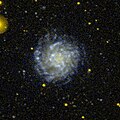| NGC 5668 | |
|---|---|
 NGC 5668 imaged by the Hubble Space Telescope NGC 5668 imaged by the Hubble Space Telescope | |
| Observation data (J2000 epoch) | |
| Constellation | Virgo |
| Right ascension | 14 33 24.331 |
| Declination | +04° 27′ 01.75″ |
| Redshift | 0.005280 |
| Heliocentric radial velocity | 1,582 ± 5 km/s |
| Distance | 80.9 ± 5.5 million light years (24.8 ± 1.7 Mpc) |
| Group or cluster | NGC 5638 Group, NGC 5746 Group, Virgo III Groups |
| Characteristics | |
| Type | SA(s)d |
| Mass | 5.7×10 M☉ |
| Size | ~48,400 ly (14.84 kpc) (estimated) |
| Apparent size (V) | 3.0′ × 3.0′ |
| Other designations | |
| IRAS 14309+0440, UGC 9363, MCG +01-37-028, PGC 52018, CGCG 047-090 | |
NGC 5668 is a nearly face-on spiral galaxy, visual magnitude about 11.5, located about 81 million light years away in the constellation Virgo. It was discovered on 29 April 1786 by William Herschel.
NGC 5668 is a member of the NGC 5638 Group of galaxies, itself one of the Virgo III Groups strung out to the east of the Virgo Supercluster of galaxies. In addition, A.M. Garcia listed NGC 5668 in the 31 member NGC 5746 galaxy group (also known as LGG 386).
As seen from the Earth, it is inclined by an angle of 18° to the line of sight along a position angle of 145°. The morphological classification in the De Vaucouleurs system is SA(s)d, indicating a pure spiral structure with loosely wound arms. However, optical images of the galaxy indicate the presence of a weak bar structure spanning an angle of 12″ across the nucleus. There is a dwarf galaxy located around 650×10^ ly (200 kpc) to the southeast of NGC 5668, and the two may be gravitationally interacting.
Supernovae
Three supernovae have been observed in this galaxy:
- SN 1952G (type unknown, mag. 17.9) was discovered by Fritz Zwicky on 18 April 1952.
- SN 1954B (type Ia, mag. 12.3) was discovered by Paul Wild on 4 May 1954.
- SN 2004G (type II, mag. 17.2) was discovered by Reiki Kushida on 19 January 2004. It was initially imaged at 43" to the west and 12".5 south of the galaxy core.
High velocity clouds of neutral hydrogen have been observed in NGC 5668, which may have their origin in supernova explosions and strong stellar winds.
Gallery
-
 NGC 5668 (SDSS DR14)
NGC 5668 (SDSS DR14)
-
 GALEX image of NGC 5668
GALEX image of NGC 5668
See also
References
- ^ Skrutskie, Michael F.; Cutri, Roc M.; Stiening, Rae; Weinberg, Martin D.; Schneider, Stephen E.; Carpenter, John M.; Beichman, Charles A.; Capps, Richard W.; Chester, Thomas; Elias, Jonathan H.; Huchra, John P.; Liebert, James W.; Lonsdale, Carol J.; Monet, David G.; Price, Stephan; Seitzer, Patrick; Jarrett, Thomas H.; Kirkpatrick, J. Davy; Gizis, John E.; Howard, Elizabeth V.; Evans, Tracey E.; Fowler, John W.; Fullmer, Linda; Hurt, Robert L.; Light, Robert M.; Kopan, Eugene L.; Marsh, Kenneth A.; McCallon, Howard L.; Tam, Robert; Van Dyk, Schuyler D.; Wheelock, Sherry L. (1 February 2006). "The Two Micron All Sky Survey (2MASS)". The Astronomical Journal. 131 (2): 1163–1183. Bibcode:2006AJ....131.1163S. doi:10.1086/498708. ISSN 0004-6256. S2CID 18913331.
- ^ R. A., Marino; et al. (July 2012), "Integral Field Spectroscopy and Multi-wavelength Imaging of the nearby Spiral Galaxy NGC 5668: An Unusual Flattening in Metallicity Gradient", The Astrophysical Journal, 754 (1): 61, arXiv:1205.5051, Bibcode:2012ApJ...754...61M, doi:10.1088/0004-637X/754/1/61, S2CID 2243509.
- "NGC 5668 -- Galaxy", SIMBAD Astronomical Database, Centre de Données astronomiques de Strasbourg, retrieved 2013-07-11.
- ^ "New General Catalog Objects: NGC 5650 - 5699". cseligman.com. Retrieved 2021-03-12.
- "The Virgo III Groups". Atlas of the Universe. Retrieved 2010-11-27.
- Garcia, A. M. (1993). "General study of group membership. II. Determination of nearby groups". Astronomy and Astrophysics Supplement Series. 100: 47. Bibcode:1993A&AS..100...47G.
- Buta, Ronald J.; et al. (2007), Atlas of Galaxies, Cambridge University Press, pp. 13–17, ISBN 978-0521820486.
- "SN 1952G". Transient Name Server. IAU. Retrieved 7 September 2024.
- Kowal, C. T.; Zwicky, F.; Sargent, W. L. W.; Searle, L. (1974). "The 1973 Palomar Supernova Search". Publications of the Astronomical Society of the Pacific. 86 (512): 516. Bibcode:1974PASP...86..516K. doi:10.1086/129639.
- Wild, Paul (1960). "Light Curves of the Supernovae of 1954". Publications of the Astronomical Society of the Pacific. 72 (425): 97. Bibcode:1960PASP...72...97W. doi:10.1086/127488.
- "SN 1954B". Transient Name Server. IAU. Retrieved 7 September 2024.
- "SN 2004G". Transient Name Server. IAU. Retrieved 7 September 2024.
- ^ Nakano, S.; et al. (2004), "Supernova 2004G in NGC 5668", IAU Circular, 8272: 1, Bibcode:2004IAUC.8272....1N.
- Elias-Rosa, N.; et al. (2004), "Supernova 2004G in NGC 5668", IAU Circular, 8273: 2, Bibcode:2004IAUC.8273....2E.
- Jiménez-Vicente, J.; Battaner, E. (June 2000), "Vertical motions in the disk of NGC 5668 as seen with optical Fabry-Perot spectroscopy", Astronomy and Astrophysics, 358: 812–818, arXiv:astro-ph/0004295, Bibcode:2000A&A...358..812J.
External links
- [REDACTED] Media related to NGC 5668 at Wikimedia Commons
| Astronomical catalogs | |
|---|---|
| NGC | |
| New General Catalogue 5501 to 6000 | |
|---|---|
| |
This spiral galaxy article is a stub. You can help Misplaced Pages by expanding it. |